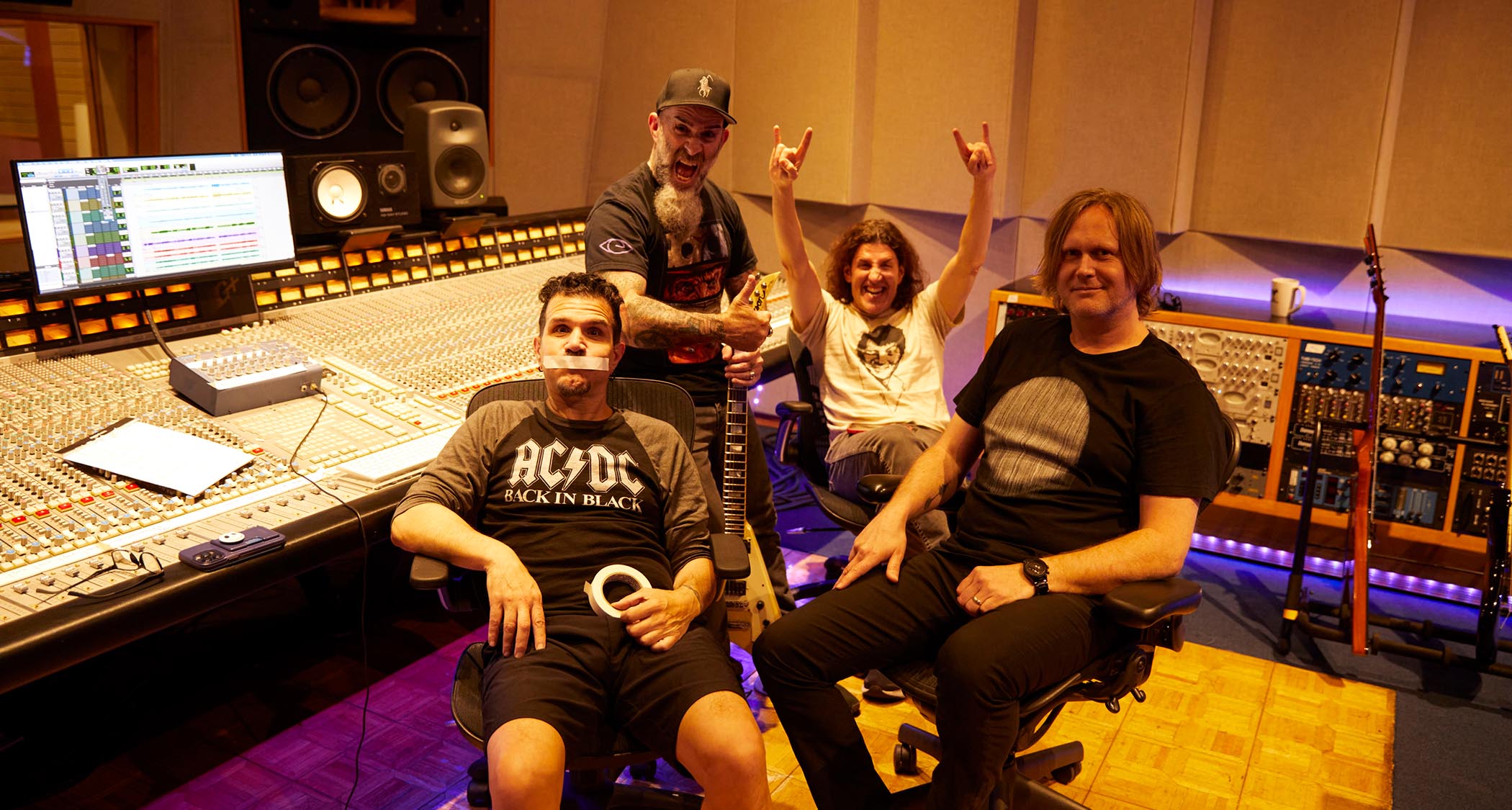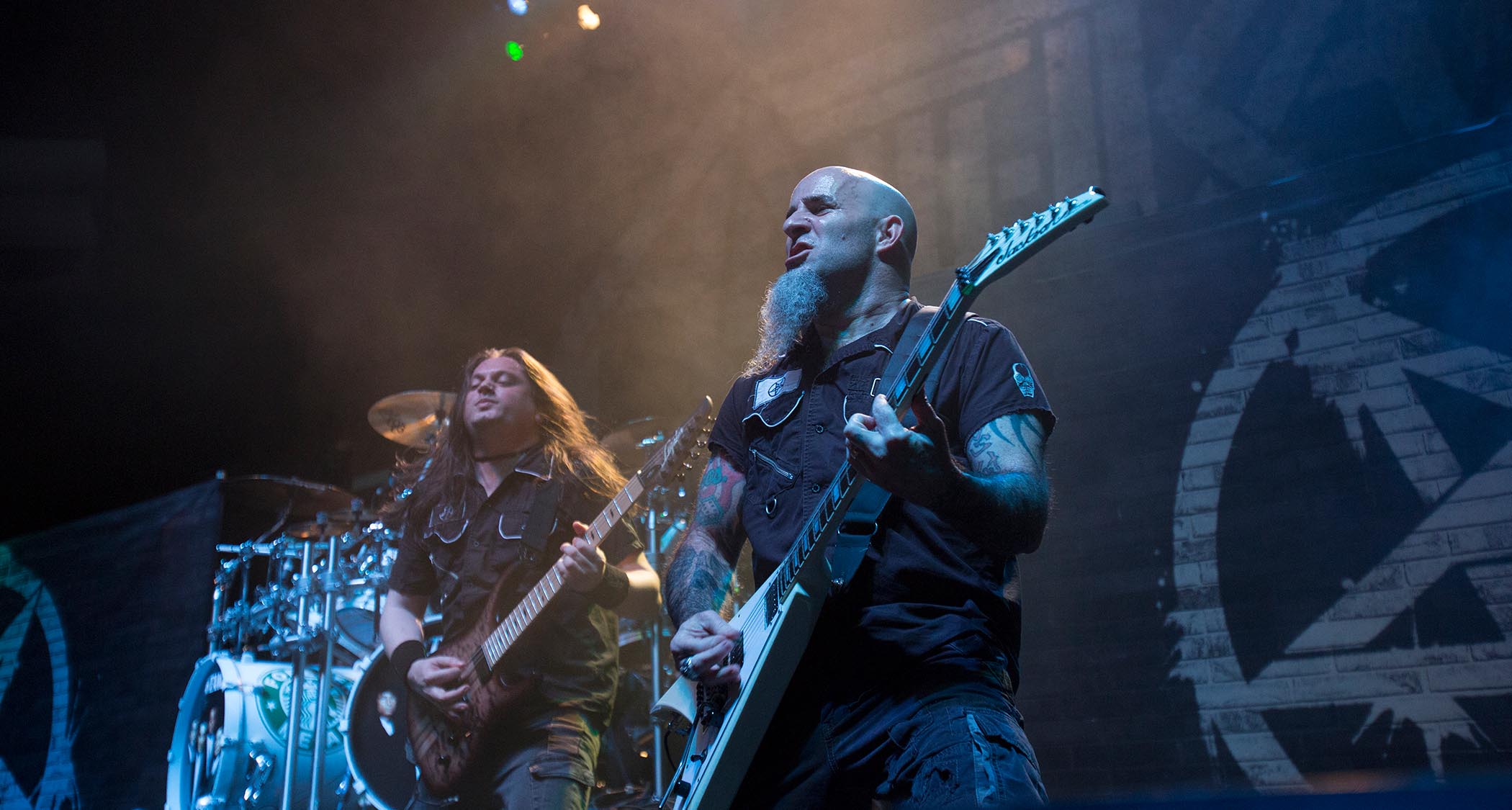
Fans champing at the bit for the follow-up to the volcanic 2016 Anthrax album For All Kings will have to wait just a little longer. In early 2024, the band hoped to have the still-untitled record out by year’s end. Now they’re shooting for a release date sometime in 2025.
“We’re taking our time and not rushing anything because we want it to be exactly how we want it,” rhythm guitarist and lyricist Scott Ian says.
“We’re not in a place in our lives anymore where we could have dropped everything and said, ‘Alright, we’ve got two months of studio time. Let’s finish writing and then get in there and record it all and do the vocals. Mix, master and we’re done – like in the old days.’ We have families and commitments now, so it can’t work that way anymore and hasn’t in a long time.”
When bands use phrases such as “It will be ready when it’s ready,” they’re sometimes stuck in limbo and are biding their time. That doesn’t seem to be the case with Anthrax. So far, the band has tracked nine songs and written and partially recorded another four.
Those songs still need leads, lyrics and vocals, but it looks like they might be done before the end of the year and the full release will hit in the second or third quarter of 2025.
At least that’s the plan; Anthrax just don’t want their first new music in a decade to be in the public’s hands until every dotted eighth note is just right – not that they’re striving to overshadow anything else they’ve done.
“I don’t think we’ve ever gone into a record saying, ‘We really need to top the last one,’ because if you did that, you’re self-fulfilling a failure,” Ian says.
“But I’m definitely loving this record. There are crushing riffs and great, hooky courses. Even some of the thrashiest songs have great choruses. We’re always looking for the hook, and I think we’ve accomplished that.”
We want this record to punch people in the face... I really want it to hit hard
Scott Ian
For now, the band’s biggest dilemma isn’t finishing the record in time, it’s deciding which nine or 10 songs will make the final cut. The most popular song from 2016’s For All Kings was the rousing anthem Breathing Lightning, and Ian says the band has written a couple of songs in that vein. However, he’s more excited about the shorter, faster tunes that are more like the material Anthrax released in their thrash metal heyday in the 1980s.
“With the songs we’ve written, we’d be able to put together a nine- or 10-song record that would be thrashier than anything we’ve done in a long time,” Ian says. “But there would also be a way to make it a very different kind of album depending on which songs we choose.
“And I can tell you, I know which way I’m leaning. And I think we’re all on the same page. We want this record to punch people in the face. And then we can use the bonus tracks for other things, but in the context of the record, I really want it to hit hard.”
When he was sent the first batch of finished songs, lead guitarist Jonathan Donais was excited by how heavy the material was and how much it reminded him of the Anthrax he grew up listening to. He was especially amped by a song that had the working title A Murder of Bros.
“I thought all the songs they sent me were great and definitely sounded like Anthrax,” Donais says. “And then I heard this one that had a black-metal feel to it that I never would have pictured Anthrax doing, and it sounds so awesome. I remember thinking, ‘Man, after being together for 40-something years and still being able to throw curveballs like that is awesome.’”
Ian is equally complimentary about Donais’ solos. “Jon has this insane ability to put together really melodic leads,” he says. “They’re memorable to the point where you could sing the solos, and, to me, that’s such a great skill. There’s always a time to have some ripping and shredding, and there’s lots of that too. But we’re lucky with Jon because he also writes these parts that you’re gonna connect with in the same way you connect with a chorus.”
Drummer and songwriter Charlie Benante started writing riffs for the new Anthrax album back in 2019. Some of the passages he wrote will likely be on the new album, but before the band got too far into the process, the pandemic hit and Anthrax entered a long period of inactivity.
“Nobody was feeling very creative – certainly not in that first six months to a year, anyway,” Ian says. “It was more kind of, ‘Let’s just be home with our families and see if the world’s gonna end or not.’ At one point, there was that uncertainty that you never knew if a gig was going to ever happen again.”
In 2021, Anthrax started playing shows again, and the fires of creativity quickly reignited. Benante started making new demos and sending them to his bandmates for feedback, and it was as if the stagnancy had never even existed.
“The ideas he sent were very realized and really good,” Ian says. “Generally, it’s just a question of, ‘Well, this part is going on for two minutes. Maybe we’ll edit that,’ which, of course, he’s fine with. The next step was to get together in a room with our editor ears on and start turning the parts into song arrangements.”
By working on three or four songs at a time, the band was able to determine which ones worked best together and what the album might still need. Instead of relying on instinct and spontaneity to create a continuous wave of energy – as they did in the early days – Anthrax drew from experience and intuition.
“I was able to look at these songs we had and go, ‘I really feel like we need a couple of three-and-a-half-minute ragers,’” Ian says. “That’s something we haven’t done in a long time, and I only heard one song that sort of fit that category.”
Charlie has got this tap that he’s able to turn on, and when it’s time for him to go to work, I’m just happy he can. He’s such a great riff writer
Ian asked Benante if he could write some faster, more direct tunes and the drummer was stoked by the suggestion. Before long, he had tapped into the kind of blinding, aggressive energy, rage and musicality that made Anthrax one of the Big 4 thrash bands of the ’80s.
“Within a few weeks, we had these two straight-up – I can’t even say they’re like songs from Among the Living because they’re shorter and tighter,” Ian says.
“It felt really good to have these songs that just rip. Charlie has got this tap that he’s able to turn on, and when it’s time for him to go to work, I’m just happy he can. He’s such a great riff writer, and I’m sure he tapped into whatever was influencing him.
“Whether it was the environment of the planet or the craziness of the world – whatever – but he was able to come up with this stuff that’s angrier and more aggressive for sure.”

Anthrax did pre-production for the album at Ben Grosse’s studio The Mix Room in Burbank and also worked at Dave Grohl’s Studio 606 in Los Angeles. “At a certain point we couldn’t get into 606 anymore,” Ian grumbles in jest. “Some band called the Foo Fighters had it booked out for a month.”
While Ian brought a wide variety of guitars, amps and cabinets into the studio, after testing them out, he returned to his tried-and-true battle-worn gear for most of the songs. He picked up his white Jackson King V, plugged into a 1982 Marshall JCM800 and EVH 5150 EL 100-watt head.
My Gibson V sounds amazing, but there’s something angrier about the King V, especially on fast songs. It’s just so mean
“My Gibson V sounds amazing, but there’s something angrier about the King V, especially on fast songs,” Ian says. “It’s just so mean.”
Ian sculpted his already vicious tone with a TC Electronic booster and his two KDHK custom pedals. The first, the Sergeant D Boost/Amp, features pre-distortion EQ circuitry Ian used in the early days combined with circuits that emulate the raw tone of amps he used in S.O.D.
The more whimsical “Jewish Space Laser” pedal uses a redesigned circuit for more clarity and depicts Ian flying through space blasting skeletons with his former go-guitar, a 1981 Gibson V, and also played a Les Paul Custom and Jackson Soloists. And he played the Les Paul and his Gretsch Malcolm Young for the clean parts.
Donais recorded his leads in his Massachusetts studio on his signature Dean USA Exile using a DAW with various plug-ins, giving Ruston the versatility to re-amp the guitars. He wrote out all the solos before playing them, then sent them to the rest of the band for approval. Often, the band kicked them back to him for tweaking, but by the third or fourth take they usually got the green light.
“Knowing that the music kicked ass motivated me,” Donais says. “When I got a song, I listened to one section at a time to wrap my head around it. And then I listened to music from other players I love, like Dimebag, Zakk Wylde and Paul Gilbert. After that, I looped the rhythm and went with whatever vibe I was getting. If I liked what I did with the first two bars, I just kept going.”
Although (or maybe because) Anthrax wrote the new album piecemeal, Ian insists the songs are among the best and heaviest the band has done since the ’80s. As much as he loves the band’s last two records, and as integral as he feels the ’90s material with vocalist John Bush was to the band’s growth, he believes the new songs will be a game-changer for Anthrax.
“I think this is going to be the album that brings back album sales,” he says. “People are going to stop streaming and buy CDs and vinyl and it’s going to change the music business for the better.” Unable to maintain the hyperbolic boast, Ian chuckles. Following a short pause, he reins himself back in and reveals his more realistic hopes.
“I’d like to think this record will be a slew of songs that people are going to be very excited about hearing live for the next few years,” he says. “I generally feel the riffs, the grooves and the breakdowns – we used to call them mosh parts in the old days – I think they’re gonna connect with our fans. And a lot of these songs are tailor-made for our live show, so I hope we’ll be playing them for a long time.”







